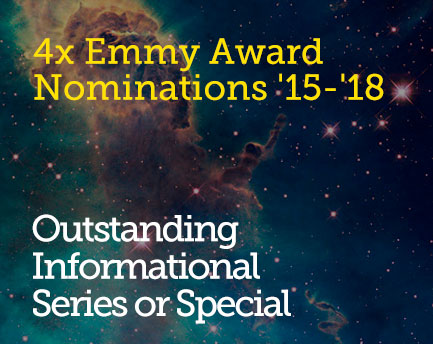July 29, 2014 7:12 pm
Reporting from the Antares Orb-2 Launch on the Student Science Experiments Program

Students from some of the participating SSEP (http://ssep.ncesse.org) schools stand with program founder, Dr. Jeff Goldstein, the morning of Antares Orb-2 launch. The students watched their experiments soar into space that same day, after many delays and much anticipation. Credit: Ken Kremer.
Today’s guest post is written by StarTalk Radio’s Social Media Coordinator, Stacey Severn, who was at the Antares Orb-2 launch Sunday, July 13 at NASA’s Wallops Flight Facility in eastern Virginia.
On the morning of the Antares Orb-2 launch, StarTalk Radio and the media were treated to a presentation by a very special group of students. The children came to watch Orbital Sciences Corporation launch their microgravity experiments to the ISS, where they will be facilitated by the astronauts in low Earth orbit. The excitement in the room was palpable as students ranging in age from Elementary through High School spoke with the press about their work, and what they hoped to learn from their experiments.
The students are participants in the Student Science Experiments Program (SSEP), launched in 2010 by the National Center for Earth and Space Science Education and the Arthur C. Clarke Institute for Science, in partnership with NanoRacks, LLC. The program concentrates on STEM learning and art education, providing student teams in communities across the nation a chance to design and compete for a spot on each mission. To date, 81 experiments have flown into space – aboard the final two Space Shuttle flights, and commercial missions by SpaceX and Orbital Sciences Corporation.

A co-investigator from Mendenhall Middle School in Greensboro, NC explains her school’s “Artificial Ear” experiment to an eager group of journalists as NASA Deputy Administrator Charlie Bolden looks on. Credit: Stacey Severn.
We heard from fifth graders about their experiment to grow lettuce seeds in microgravity with no light, and middle-schoolers explained their study of Calcium Sulfate crystals and their growth in space, to possibly determine why jellyfish flown into space might have developed vertigo. The students wonder if this might happen to humans born in space, and are hoping to gather useful data.

Students from Rockland County, NY standing with their presentation detailing their experiment on the effects of microgravity on the growth of lettuce seeds, along with their mission patches and artists Olivia Jones, a fourth grade student at Cottage Lane Elementary School, and Carlee deFrancesco a 9th grade student at Tappan Zee High School. Credit: Stacey Severn.
A student representing another middle school talked about an experiment designed to gauge how different coatings might guard against rusting in space. A fourth team talked about a microencapsulation experiment, and a fifth explained their hypothesis about bread molding in space. In all, 15 experiments (dubbed the “Charlie Brown Mission”) are now aboard the ISS, culled down from 1,344 proposals by a total of 6,750 teams. In addition to hearing about student research, we were treated to views of award-winning patch designs for the mission created by art students in Rockland County, NY.

Zaire McQueen, Co-Principal Investigator, describing “Experiment: Affected Efficacy of Sprayed Enamel Coating as a Corrosion Inhibitor.” Milton Olive Middle School, Wyandanch Union Free School District, NY. Credit: Ken Kremer.
Astrophysicist and program founder Dr. Jeff Goldstein explained the SSEP program eloquently:
“Very young students like to poke their universe and see what happens. If you look at a baby, they will explore near vs. far, and up vs. down, and color and texture, and the act of poking the universe requires the universe to present evidence in return. There’s data that comes back, and that allows us to understand how the universe works. It helps us to understand how we interact with the universe.
“That’s called evidence-based learning. We’re born curious, and we’re born evidence-based learners. If you ask professional scientists and engineers what is it they do, they’ll tell you that they’re in the business of organized curiosity; asking smart questions, but fundamentally in the business of curiosity. Practicing scientists and engineers are also in the business of evidence-based learning for the entire human race.
“Since our children are doing science every day of their lives, evidence-based inquiry-based learning, they are perfectly capable of poking the universe in research right now to see it for themselves. So this program was designed as a community engagement model for absolutely authentic immersion in every facet of real research.”
Get the most out of StarTalk!
Ad-Free Audio Downloads
Ad-Free Video Episodes
Stickers & Mugs
Live Streams with Neil
Priority Cosmic Queries
Early-Access Videos
Learn the Meaning of Life
...and much more

 Become a Patron
Become a Patron

